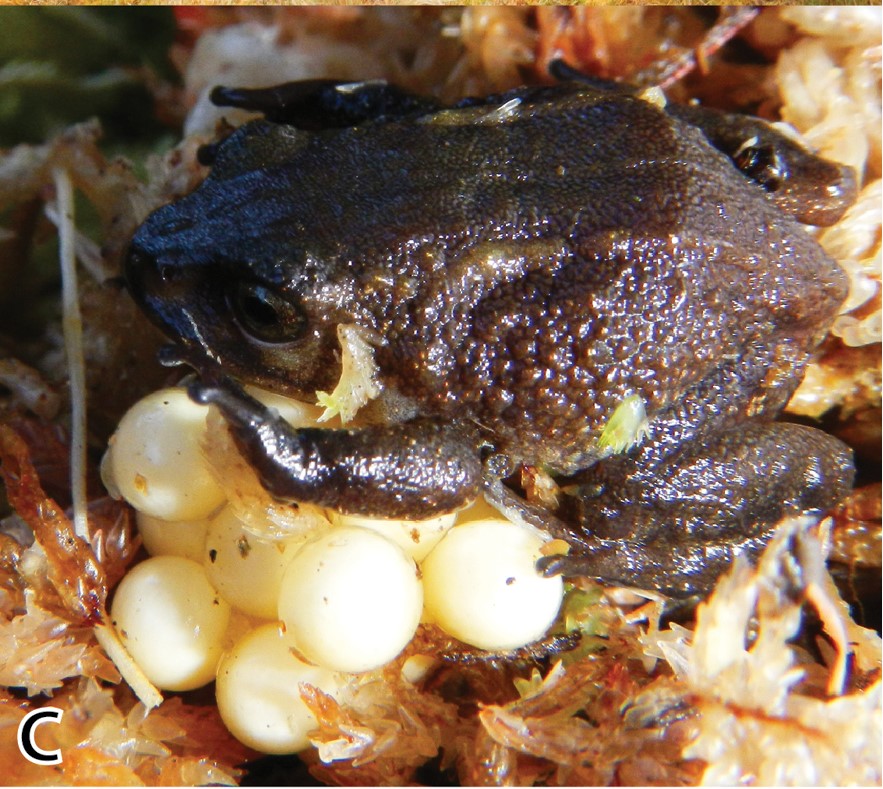At least a dozen new species of frogs have been discovered this year in Peru. Scientists suggest these species are already endangered, despite the remoteness of their habitats. Conservation efforts are of little help without local involvement.
While not as charismatic as dolphins or hummingbirds, frogs are fascinating animals that act as outstanding indicators of environment quality. Their complex life cycle depends on high-quality water from rain and streams where their tadpoles can thrive, as well as very specific foods and plenty of nooks and cranes to to engage in their hide-and-seek game of survival.
The newly discovered Inti Andes Frog (Phrynopus inti), an interesting species that has no tapole stage but instead rears its young directly into tiny fully-formed froglets, was first seen in May 2017. Additional fieldwork in June and July led to intensive lab work and a detailed paper published earlier this month.

P. attenboroughi, another of several new species in the area, guards its egg cluch on a moss pad. This species was named after naturalist and documentarist David Attenborough. Photo: E. Lehr.
The species, completely new for science, is already in danger of extinction despite being found only in the remote Pui Pui Protected Forest, in the easternmost tip of the Junin region.
This new species comes to join a trend. National Geographic, which funds some of these expeditions to explore biodiversity in remote areas of Peru, reported three more new species in the same area are threatened as well.
A disheartening reality
Each year, dozens of welcome new additions to Peruvian biodiversity are found to be already under threat as a consequences of human activities.
“Despite that two locations of the known distribution of Phrynopus inti are within the Pui Pui Protected Forest and are formally protected, other factors such as fungal infections, climate change, pollution, and man-made fires (used to expand grazing areas for livestock) continue to be threats for many Andean amphibians—even inside protected areas,” states the paper describing the new Inca Andes Frog.
Even if scientists manage to discover and formally describe a species, another problem arises: wildlife trafficking.
In Peru, local hunt down the Titicaca Water Frog (Telmatobius culeus) and other species for consumption and sale, which has decimated the species to a critically endangered status. On the other hand, breeders and hobbyists, mostly from Europe and the US, are willing to pay significant amounts of money for an individual or a breeding pair of the rarest and most beautiful species of frogs.
Of special interest are Poison Dart Frogs, commonly found in pristine forests of the moist lowlands of Peru. Known for skin secretions some indigenous tribes use to poison their arrow tips, these frogs use their bright colors to warn predators about their poisonous coating.

Ranitomeya mirabilis, one of the colorful species of Poison Dart Frogs from Peru subjected to trafficking.
Between the sword and the wall
For savvy traffickers, scientific papers are goldmines. Scientific rigor requires that a paper describing a new species includes the specific location where it was found. GPS coordinates were listed on these papers, making it easier for other scientists to visit the location and study the species.
Repeated raids to sampling areas specified in scientific papers have forced scientists to start being less precise about the location. Today, many conscious zoologists list only a general location or the nearest human settlement when describing species they know will be attractive for traffickers.
In remote areas of high biodiversity, these traffickers create a profitable market that relies on impoverished locals. While a couple of dollars for catching a frog might not sound like much, it is an attractive incentive for poorer people in rural areas of Peru.
Unfortunately, these locals are the same people scientists rely on for guidance in the wilderness and tips from local knowledge of flora and fauna. Without any educational or monetary incentives to preserve fauna, locals are likely to play for both sides—traffickers’ and scientists’—to earn a day’s wage.









